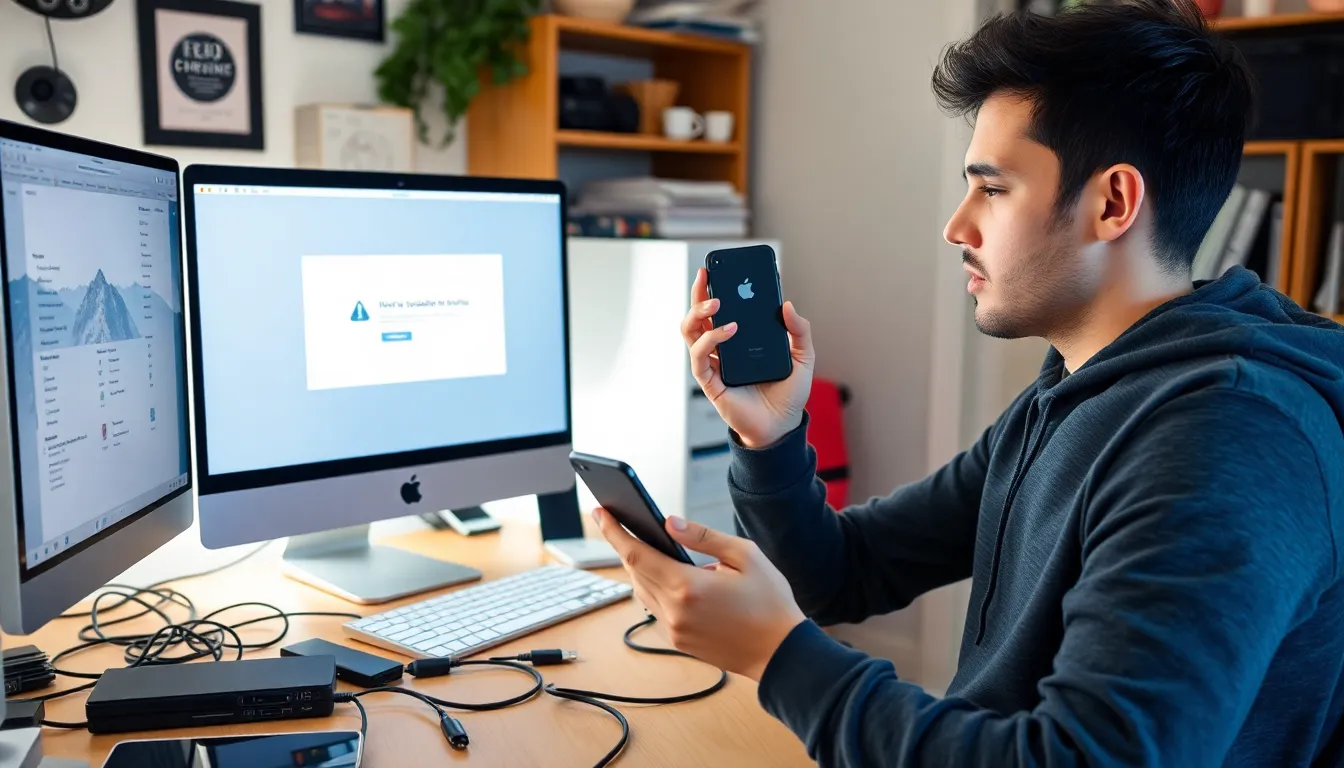Picture this: you’re all set to transfer those precious photos from your iPhone to your PC, but suddenly your phone decides to play hide and seek. Frustrated, you’re left staring at your screen, wondering if your iPhone has taken an extended vacation. This common tech hiccup can feel like a scene from a bad comedy, but it doesn’t have to be.
Whether it’s a pesky cable issue or a software glitch, the “can’t see iPhone on PC” dilemma has baffled many. But fear not! With a few simple troubleshooting steps, you can reclaim your connection and get back to sharing those memories. Let’s dive into the reasons behind this mystery and uncover the solutions that’ll have your devices chatting in no time.
Table of Contents
ToggleCommon Reasons You Can’t See iPhone on PC
Several factors contribute to the issue of an iPhone not being recognized by a PC. Understanding these common problems can facilitate effective troubleshooting.
USB Connection Issues
Connection problems often stem from the USB cable. Damaged or non-certified cables hinder communication between devices. Users should inspect for fraying, bent connectors, or loose ports. Switching out the current cable may quickly resolve the problem. Additionally, testing different USB ports on the PC could lead to a successful connection. Users should ensure the USB ports are working to eliminate this variable.
Software Compatibility Problems
Compatibility between software often leads to connection failure. Outdated drivers on the PC can prevent proper device recognition. Keeping iTunes updated is crucial, as this software aids in establishing a connection. Users must regularly check for Windows updates, which can enhance compatibility. Furthermore, the latest iOS version on the iPhone can improve connectivity. A mismatched version between devices may disrupt the interaction during data transfers.
Troubleshooting Steps

When an iPhone isn’t recognized by a PC, users can follow these troubleshooting steps to resolve the issue effectively. Each step targets common causes, ensuring a thorough approach to connectivity problems.
Checking USB Cables and Ports
Inspecting USB cables and ports plays a vital role in establishing a connection. Damaged cables contribute significantly to recognition issues. Users should try different USB ports on the PC, as one might be faulty. Certified cables should be used for optimal performance. Checking for any debris in the ports could also enhance connection quality.
Restarting Devices
Restarting devices often resolves temporary glitches. Powering off both the iPhone and the PC allows any lingering errors to clear. Users should wait a minute before turning them back on. This simple action can restore recognition, as it refreshes the system settings. After rebooting, reconnecting the devices may successfully establish the connection.
Updating iTunes and Drivers
Keeping iTunes and drivers up to date is crucial for device recognition. Outdated software often leads to incompatibility issues. Users should check for the latest version of iTunes and install it if necessary. Additionally, updating USB drivers through the PC’s Device Manager can enhance connectivity. Regularly updating iOS on the iPhone prevents compatibility issues and ensures smoother communication between devices.
Alternative Solutions
Several alternatives exist for addressing the issue of a PC not recognizing an iPhone. Users can explore both third-party software and wireless transfer options for effective solutions.
Using Third-Party Software
Third-party applications offer reliable solutions for iPhone and PC connectivity. Popular options include iMazing and AnyTrans, which facilitate seamless file transfers between devices. Users can transfer photos, videos, and other files without dependency on iTunes. Many of these applications support different formats and provide enhanced functionalities, such as direct edits or backups. Installation is straightforward, and most offer free trials, allowing users to evaluate features before purchase.
Wireless Transfer Options
Wireless transfer options simplify the process of sharing files between an iPhone and a PC. Applications like AirDrop are ideal for instant sharing but require compatible devices. For broader use, cloud services like Google Drive and Dropbox allow users to upload files from the iPhone and access them on a PC. Setting up a Wi-Fi connection enables faster transfers, which bypasses USB limitations. This method often enhances convenience, especially when dealing with large files or multiple images. Adjusting settings on both devices ensures smooth communication and transfer success.
Preventing Future Issues
Maintaining a smooth connection between an iPhone and a PC requires consistent attention to a few key aspects. Users can adopt proactive measures to prevent future connectivity issues.
Regular Software Updates
Keeping the iPhone’s iOS and the PC’s software up to date considerably enhances device compatibility. iTunes and drivers must also receive regular updates to avoid any communication gaps. When he installs the latest software versions, he ensures the devices speak the same language, which is crucial for recognition. Schedule periodic checks to confirm all components are current, including optional updates, which can enhance performance.
Proper Device Management
Implementing effective device management techniques contributes to smoother interactions. Users should periodically inspect USB cables for wear and tear, replacing damaged equipment promptly. Keeping USB ports clean and free of debris aids in establishing a reliable connection. Additionally, organizing files and photos on the iPhone makes it easier to transfer data without complications. Prioritizing careful device handling prolongs the lifespan of both the iPhone and the PC, safeguarding against future recognition issues.
Resolving the issue of an iPhone not being recognized by a PC can be straightforward with the right approach. By checking cables and ports ensuring software is up to date and exploring alternative transfer methods users can regain seamless connectivity. Implementing these strategies not only solves current problems but also helps prevent future issues. With a little attention to detail and proactive maintenance users can enjoy hassle-free photo transfers and efficient device management.




